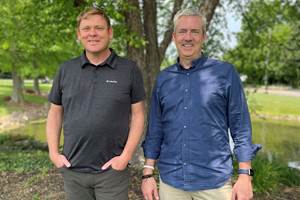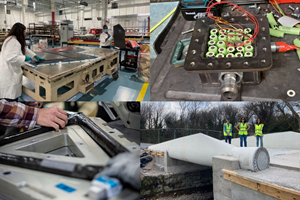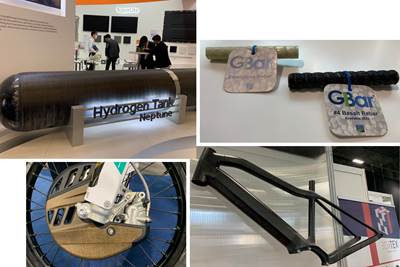Sustainability has come to composites and it's here to stay
It might be tempting to think of sustainability as a buzzword, but there are structural changes taking place in the composites industry that signal its permanence.
Share
Read Next

Photo Credit: Getty Images
In 2016, my youngest son was 17 and nearing the end of high school. I speculated, on this page, about the kind of career he might pursue, even going so far as to suggest that he might choose something related or adjacent to the composites industry. I also discussed the challenges young people face sorting out and evaluating their academic and work options.
A couple years later, in 2018, I wrote about that same son — 19 at the time — as my wife and I prepared to take him to his first year of college. This time, the focus of my editorial was to contrast the value of education, which our son was about to pursue more assiduously, against the value of experience, which comes only with time and effort. I was specifically concerned about the loss of experience the industry was suffering with the retirement of the Baby Boomer generation that was so instrumental in the composites industry’s development.
Today, he’s 23, recently graduated from college, and we know much more about the kind of career he might have. His undergraduate degree is in marketing, but next month, he’s beginning the pursuit of his MBA in a specialized program at Colorado State University (CSU) that focuses on sustainability. Called Impact MBA, the program focuses on helping graduates develop the ability to combine strong business acumen with strong sustainability acumen.
What we are finding, however, is that saving weight is not enough anymore.
So, what’s driven my son’s interest in this program? First, he said, “I want my work and career to matter and have meaning, and I think this is a way to do that.” Second, he said, “I have been frustrated by the lack of political action on climate change, and rather than be frustrated, I want to do something about it.” Third, he noted that, “It’s a profession that’s in high demand. That’s appealing.”
Of course, my son’s not alone. His generation in particular is highly attuned to how their decisions affect the planet’s health and, by extension, the health of the human race. This is important because such decision making affects their spending habits in ways that the business world cannot ignore. Therefore, consumer products and services that align with these values and priorities will be of utmost importance.
On top of this, many countries — particularly those in Europe — are implementing policies to compel businesses and products to follow planet- and people-friendly practices. This affects everything from energy resource management to raw material feedstock development to emissions mitigation.
All of this — business- and policy-driven efforts toward sustainability — were on full display in May at the JEC World 2022 exhibition in Paris. It was clear, just being at the show a few hours, that there is an across-the-board effort to develop products, services and technology that mitigate carbonization through reduced energy and material consumption, and enable customers to achieve sustainability goals.
Composites, of course, have for a very long time relied on key properties in sustainability — including light weight and long service life — as a tool to displace legacy materials such as steel, aluminum, concrete and wood. In fact, the increased fuel efficiency made possible by lightweighting was one of the reasons Boeing and Airbus applied carbon fiber so extensively to the 787 and A350, respectively. What we are finding, however, is that saving weight is not enough anymore. Composite materials suppliers, equipment builders and fabricators are being tasked with implementing robust and widespread sustainability strategies in order to win or even keep business.
As heartening as this sustainability focus might be, there are signs everywhere that this is an immature and fast-evolving discipline that will, in the short term, be difficult to parse and navigate. Standards, best practices and proven tools are few, which I fear will compel a lot of you to throw spaghetti at the wall of sustainability, to see what sticks.
On top of that, there is no sustainability cure-all — no single solution or decarbonization strategy to rule them all. This will leave you pursuing incremental improvements and strategies, some of which will, undoubtedly, have a carbonization downside of their own that you did not anticipate. That is, everything comes at a cost.
This multi-faceted, dynamic, somewhat chaotic pursuit of sustainability is at once exciting and daunting, and it’s also here to stay. Maintaining the livability of our home (earth) is not an option. I think my son has a lot to do.
Related Content
Up, not out: The next chapter of CompositesWorld
I have been editor-in-chief of CompositesWorld for 17 years, which translates into a lot of editorials. This will be my last as I become publisher of CW. We welcome Scott Francis back to the brand to take my place.
Read MoreAs 2023 begins, a look back at trending CW topics in 2022
With 2022 now behind us, CW’s editor-in-chief Jeff Sloan takes a look at the CW stories last year that received the most reader attention.
Read MoreThe future of carbon fiber manufacture
Later this month, CW’s 25th anniversary Carbon Fiber Conference promises to be among the most important as dynamic market forces are putting unusual pressure on the carbon fiber supply chain.
Read MoreWhy aren't composites synonymous with infrastructure?
The U.S. seems poised to invest heavily in infrastructure. Can the composites industry rise to the occasion?
Read MoreRead Next
JEC World 2022, Part 3: Emphasizing emerging markets, thermoplastics and carbon fiber
CW editor-in-chief Jeff Sloan identifies companies exhibiting at JEC World 2022 that are advancing both materials and technologies for the growing AAM, hydrogen, automotive and sustainability markets.
Read MoreJEC World 2022, Part 1: Highlights in sustainable, digital, industrialized composites
JEC World 2022 offered numerous new developments in composites materials, processes and applications, according to CW senior editor, Ginger Gardiner, most targeting improved sustainability for wider applications.
Read MoreJEC World 2022, Part 2: Recycling, natural fibers and additive manufacturing
CW associate editor Hannah Mason recaps several technologies seen on display at JEC World 2022, including new developments from Bcomp, Massivit 3D, Gen 2 Carbon and more.
Read More


























